- About MAA
- Membership
- MAA Publications
- Periodicals
- Blogs
- MAA Book Series
- MAA Press (an imprint of the AMS)
- MAA Notes
- MAA Reviews
- Mathematical Communication
- Information for Libraries
- Author Resources
- Advertise with MAA
- Meetings
- Competitions
- Programs
- Communities
- MAA Sections
- SIGMAA
- MAA Connect
- Students
- MAA Awards
- Awards Booklets
- Writing Awards
- Teaching Awards
- Service Awards
- Research Awards
- Lecture Awards
- Putnam Competition Individual and Team Winners
- D. E. Shaw Group AMC 8 Awards & Certificates
- Maryam Mirzakhani AMC 10 A Awards & Certificates
- Two Sigma AMC 10 B Awards & Certificates
- Jane Street AMC 12 A Awards & Certificates
- Akamai AMC 12 B Awards & Certificates
- High School Teachers
- News
You are here
Mathematical Treasure: Euclid in China
The First Translation of Euclid’s Elements into Chinese
In 1601 a group of Jesuit missionaries led by Matteo Ricci, S.J. (1552-1610) entered mainland China, seeking to evangelize the Chinese to Christianity. However, the Chinese did not wish to be converted to this new and foreign religion and the missionaries found these supposed “pagans” to be a highly civilized and moral people. The task of conversion would be difficult and prolonged. The missionaries settled in, learning the Chinese language and adopting many Chinese customs. While not interested in the alien religious knowledge these Europeans brought with them, Chinese officials valued the technical and scientific skills the Jesuits possessed.

The depiction of Matteo Ricci and Xu Guangqi above is from Adam Kirchen’s China Monumentis (1667) and is provided courtesy of Boston College’s Ricci Collection. Upon conversion to Christianity, Xu took the name Paul Li by which he is identified in the illustration.
The Jesuit order of Catholic priests was founded to counter the advances of the Protestant Reformation. While they were schooled in theology, each individual also possessed an academic background in the arts and sciences of the times. Readily accepted as scholars, the Jesuits were admitted into official Ming Court circles where they advised the Chinese in the fields of calendar reform, astronomy, cartography, the casting of cannon, and mathematics. Matteo Ricci translated western mathematics texts into the Chinese language. Assisted by one of his converts, Xu Guangqi, Ricci in 1607 began translating Euclid’s Elements into Chinese. The text they used for the work was the 1574 Latin commentary, Euclidis elementorum libri XV, of Christopher Clavius; this was the best available European text of Euclid at this time and Ricci had studied under Clavius. Ricci and Xu undertook the translation and transcription of only the first six books of Euclid’s Elements. Their work, Yuan rong jioa yi [Treatise on Geometry], was published in Beijing in 1614. The images shown below are from an 1847 edition of this book.

This is the title page of Treatise on Geometry.

This is the first page of text bearing the seals of the authors and censors.
In his Preface, Ricci addressed his Chinese audience, noting:
[The Elements] proceeds from the evident to the particular details, from doubt to certainty. What appears useless is very useful, in fact it is the foundation of everything [postulates and common notions appear useless but in fact they are the ‘foundation of everything’] it is true to say that it is the basic form of the myriad forms, the medium for a hundred schools of learning.
Additional pages from Ricci's and Xu's translation follow.




The text contained eighteen propositions. The sphere and its volume were discussed as an example of divine perfection. The Jesuits still held to the concept of a universe comprised of nested spheres and attempted to promote this idea among the Chinese; however, court astronomers rejected this notion. Noting that everything on Earth has a shape, the text went on to explain the properties of circles, rectangles, polygons, and the equilateral triangle. The sphere was promoted as the geometric object possessing the greatest volume.
While some Chinese scholars found the deductive method of reasoning fascinating and useful, in general Treatise on Geometry had little impact on Chinese mathematics. In the work, Xu wished to translate the whole of Clavius but Ricci, perhaps first desiring to see the effect of their work, held back hoping someone else would complete the project. The translation was finally completed in 1875, when the official scholar, Li Shanlan, and a western translator, Alexander Wylie, translated the remaining books of Euclid’s Elements. For the events surrounding this translation, see Swetz [1974].
The six images of Ricci's and Xu's Treatise on Geometry supplied above were obtained with permission and through the kind cooperation of the National Central Library, Taiwan.
The Second Translation of Euclid’s Elements into Chinese
In 1644 the Ming Dynasty (1368-1644) fell and was replaced by the Qing Dynasty (1644-1911) founded by invading Manchus. A Jesuit mission still remained in the Imperial Court. The Manchu Emperor Kangxi desired Western knowledge particularly in science and mathematics and chose two French missionaries, Jean Francois Gerbillon and Joachim Bouvet, to tutor him in these disciplines. They thought Ricci and Xu’s Geometry too complicated for instructional purposes and undertook their own translation of Euclid’s Elements.
For this task, they employed Elements de geometrie (1671) by the French Jesuit Ignace Gaston Pardies (1636-1673). Pardies had broken with tradition and, in addition to the work of Euclid, also included theories of Archimedes and Apollonius in his Geometry. Gerbillon and Bouvet’s translation, Ji he yuan ben [The Elements of Geometry], appeared during the early 1690s. The images shown below are very rare, as they are from an original handwritten copy, corrected and annotated by the Emperor himself. These images were provided by The National Central Library, Taiwan.

The first page of the text

A discussion of the circle

Definitions of parallelism of lines
Reference
Frank Swetz. “The Introduction of Mathematics in Higher Education in China, 1865-1887.” Historia Mathematica, Vol. I (May, 1974), pp. 167-179.
See the Index to Mathematical Treasures here in Convergence for images from the 16th century editions of Euclid's Elements by Clavius and Pardies noted above.
Frank J. Swetz (Pennsylvania State University, "Mathematical Treasure: Euclid in China," Convergence (October 2013)




